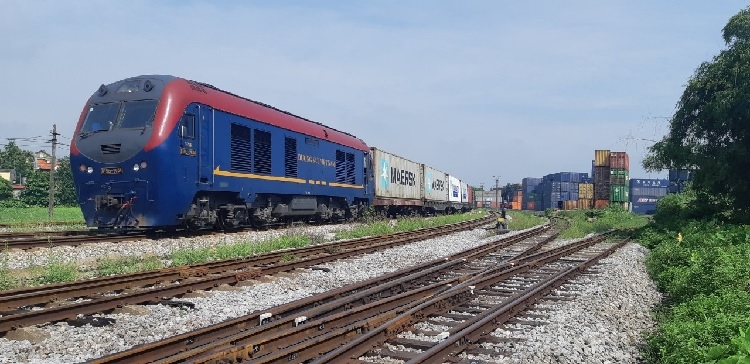Direct EU-Vietnam cargo train heralds in new prospects for the railway industry
 |
| The first container train from Vietnam to Belgium departs from Yen Vien Station, photo: VGP/PT |
Railway Transport and Trading JSC (Ratraco) began operation of the first direct container cargo train from Vietnam to the European Union on July 20. How important is the event to the company and the railway industry as a whole?
For years, the railway industry has been operating Vietnam-EU cargo trains. However, the transportation of commodities to the EU was part of trains and did not run on a regular schedule. This is the first time we have a full train of Vietnamese-EU cargo that has run regularly on schedule. This also marks the first time we have been able to build with different partners like Maersk and Asia-European railway transport agents. This event is vital for Ratraco and the railway industry in the context that it enables railways to promote their abilities and advantages in the Asia-European link, especially during the pandemic.
Furthermore, cargo transportation by sea is facing some challenges due to a lack of empty containers and more effects. Thus, it brings about an alternative for businesses. On-time schedule and reasonable charges are the two advantages of the railway industry that we are going to promote more. Railway charges are cheaper than aviation transportation, but more expensive than maritime transport. However, railways can handle huge volumes of goods and ensure safety, while protecting the environment.
Why did the railway industry decide to partner with Maersk and Asia-European railway transport agents in this business, and what are your expectations from the cooperation?
We have taken time to have discussions and meetings with Maersk and others. We have built experience in container cargo transportation for years, and has a number of partners from Vietnam, China, Russia, and the EU. Therefore, we win their confidence.
Maersk is an international company and the largest operating subsidiary of the Danish conglomerate Maersk Group. It has a presence worldwide, enabling it to handle issues related to empty containers, for example. We expect that the cooperation will help Ratraco and the railway industry increase cargo train volume, thus increasing revenues and profit, and help open a new approach to business performance in these challenging times and further ahead.
We and our EU partners are working on plans to operate eight trains each month from Vietnam. We will increase the frequency when more favourable conditions come. At present, the number is reasonable with customers’ demands. Currently, cargo trains on this route handle mostly textile and garment items, footwear, and electronic products.
Cargo transport can prove to be an optimal solution for the railway industry. How have cargo trains helped cover losses from other business segments?
For Ratraco, since the pandemic emerged in Vietnam, cargo trains have been operating normally. And in the first six months of 2021, the growth continues with cargo trains. Ratraco is now operating trains from Vietnam to third countries like Mongolia, Kazakhstan, Uzbekistan, Russia, Tajikistan, Poland, Germany, and the UK. Meanwhile, the railway industry still saw strong drops in passenger trains due to halts. In an effort to partly cover losses from passenger trains, it has been focusing more on cargo transport on the Asia-Europe railway route.
Last year, the industry saw strong growth in cargo transportation, and that growth momentum continued in the first half of 2021. According to Vietnam Railways, the industry’s total volume of train cargo surpassed the yearly target and rising strongly over the same period last year. Among traditional items, the volume of Apatite ores rose 31 per cent, coal (up 10 per cent), and fertiliser (up 8 per cent).
What the stars mean:
★ Poor ★ ★ Promising ★★★ Good ★★★★ Very good ★★★★★ Exceptional
Related Contents
Latest News
More News
- Vietnam GDP posts second-strongest growth since 2011 (January 06, 2026 | 08:35)
- Double-digit GDP growth within reach with shift to higher-value expansion (January 06, 2026 | 08:33)
- Ho Chi Minh City projects $10.5 billion remittance inflows in 2025 (December 31, 2025 | 18:58)
- Digital shift reshaping Vietnam’s real estate brokerages (December 31, 2025 | 18:54)
- New decree sharpens enforcement in securities market (December 31, 2025 | 18:53)
- Voluntary Sustainability Standards pave way for Vietnam’s agricultural exports (December 31, 2025 | 09:00)
- Gold market reform advances as SBV receives applications for bullion production (December 30, 2025 | 12:07)
- Textile apparel firms deliver robust earnings despite global tariff pressures (December 30, 2025 | 10:09)
- Ho Chi Minh City hits $8.37 billion in FDI (December 29, 2025 | 08:28)
- Tax sector wraps up 2025 and sets priorities for next year (December 25, 2025 | 14:00)

 Tag:
Tag:





















 Mobile Version
Mobile Version